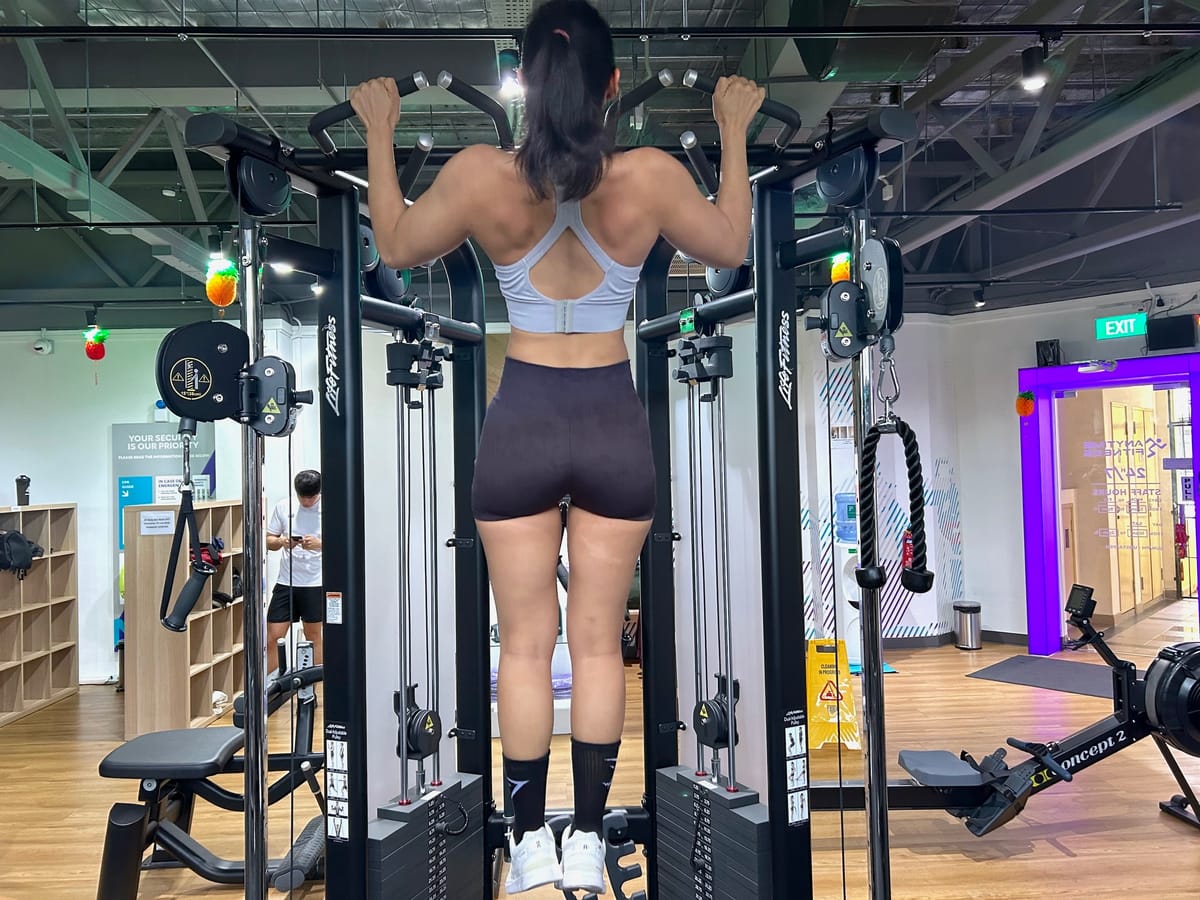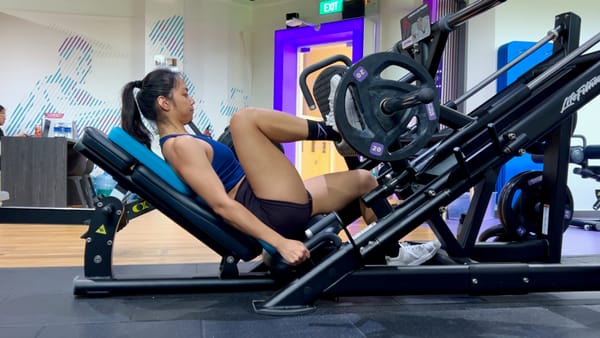How to Do a Pull-Up (4 Steps to Do Your First in 8 Weeks)
Learn how to do a pull-up in just 8 weeks. 4 simple steps with exercise progressions, tips, and training plan. For trainees of all levels.

Let’s be honest: figuring out how to do a pull-up is much trickier than it looks!
Don’t be fooled by people you see casually repping it out in the gym. They were once struggling to get their first, too.
The good news?
You’re reading this, which means you’re (somewhat) ready to struggle! And we’re going to show you how.
What muscles do pull-ups work?
OK, we know you’re not here for anatomy (yawn!) … but let’s just talk about this briefly.
You need to know what muscles are important in a pull-up so you can target them in your training.
Here are the muscles you should prioritize since they have the highest levels of activation during a pull-up.
Lats
Refers to the latissimus dorsi.
The lats is the broad, flat muscle on your back that looks like “wings” if they get big enough. Feel it by running your hand down from your armpit toward your waist.
The main role of your lats in a pull-up? Shoulder adduction — which is the bringing of your arms down toward the sides of your body.
Biceps
Whenever you do a pulling movement, your biceps will be involved.
In a pull-up, the main functions of your biceps are flexion (bringing the wrist toward the shoulder) and supination (outward rotation) of the forearms.
Traps
The traps can be divided into 3: the upper, middle, and lower trapezius.
It’s a diamond-shaped back muscle that runs from the neck down to your mid-back.
What roles do your traps play during a pull-up?
The middle trapezius brings your shoulder blades back, while the lower trapezius brings your shoulder blades down. Both of these are “primer” movements of a pull-up.
How to do a pull-up in 8 weeks (or less)
Now, for the exciting part where you put in the work, and hope your body overcomes gravity successfully.
Setting expectations
This training plan is suitable for most trainees, including beginners! Of course, you should be in good health and able to perform the exercises reasonably well.
OK, so all you need is 8 weeks? Well …
Your timeline can vary based on consistency, current fitness level, recovery, and weight (yes, you’re literally pulling your whole body up).
You’ll find 4 steps in this pull-up training plan, with each getting progressively harder.
How the training works
More advanced trainees should skip to Step 2 (or even Step 3).
The duration is just a guide. Use your own judgment to decide when it’s time to move on to the next step.
That said, don’t be too eager to cut back on exercises you’ve done in previous steps.
They contribute to your pull-up cumulatively.
Also, the exercises shared here are simply suggestions! So if you know what you’re doing, feel free to replace or modify them based on preference.
Most importantly, work on your pull-up as part of a well-rounded training program! The pull-up is just the cherry on top, not your only goal.
Step #1: Build your grip strength (from Week 1)
First thing you need to do for a pull-up? Hang on to a bar without losing grip.
That calls for some serious grip strength, which you’re going to work on in this step.
The goal here is to strengthen the flexor muscles of your forearms so your hands can stay closed during a pull-up. A strong grip is essential for the back exercises you’ll be doing later on.
Be warned: this is the most boring (and literally very painful) step.
And oh … say bye-bye to baby soft hands.
No issues with grip? Skip to Step 2 to save about 2 weeks.
Exercise #1: Dumbbell hold
One of the simplest, but most effective ways to develop grip strength.
All you need is a pair of heavy dumbbells.
Recommended: 3 sets, 20 to 30 seconds hold
To perform the dumbbell hold:
- Choose a pair of dumbbells you can hold for 20 to 30 seconds.
- Pick up the dumbbells and hold them by your side, making sure to squeeze your hands tight.
- Hold for 20 to 30 seconds.
If you want to get more out of this (or because it’s so boring), turn this exercise into a farmer’s walk or dumbbell shrug instead.
Exercise #2: Plate pinch
Similar to the dumbbell hold, the plate pinch improves your grip.
The only difference is this time, you’re pinching. You’ll be handling less weight, and your thumb has to work a lot harder (vs. dumbbell hold).
Recommended: 3 sets, 20 to 30 seconds hold
To perform the plate pinch:
- Choose weight plates you can hold for 20 to 30 seconds.
- Stand the weight plates up on their sides, and hold them up by pinching with all fingers.
- Hold for 20 to 30 seconds.
Just like with the dumbbell hold, the plate pinch can be combined with a farmer’s walk or shrug too. But it wouldn’t be as productive because the pinch grip severely limits the weight you can hold.
You’ll likely be straining too hard to keep the grip on anyway.
Exercise #3: Dead hang
Just as boring because you’re simply holding on, but this will feel the most applicable to the pull-up.
Recommended: 3 sets, to failure
To perform the dead hang:
- Use a grip of ~1.5 times shoulder-width.
- Hang on as long as you can, keeping a tight squeeze on your grip.
- Hold on tight till your grip starts to fail (or it hurts so much you can’t hold on).
The dead hang could get pretty painful the first few times you try it. When your grip isn’t strong enough, it loosens gradually, and this gets your skin (at the bottom of the fingers) wedged against the bar.
Fortunately, this goes away pretty quickly once you start working on your grip strength consistently.
Easily doing bodyweight dead hangs for 60 seconds (or more)? Make it more challenging by using a dip belt to add weight!
This keeps you sane by reducing the amount of time you need to hang for. And well … it just feels badass doing it.
How to add these exercises to your training?
Spread all 3 exercises evenly across the week.
For all grip exercises, place them last in your training program. You don’t want a fatigued grip limiting what you can do on other exercises.
If you have to prioritize, go with the dead hang. It’s the most applicable to the pull-up.
Step #2: Strengthen muscles used in pull-ups (from Week 3)
Woo-hoo! You now have the grip strength to hold on to a bar (probably even while dozing off).
This also means you can comfortably perform the next few exercises without losing grip.
This step focuses on getting your back muscles stronger with movements similar to what you’d do in a pull-up.
Think of it as a pull-up broken down into more manageable parts!
Exercise #1: Scapular pull-up
Think of this as a dead hang — but upgraded.
The scapular pull-up requires you to squeeze your shoulder blades together while in a dead hang position.
To be more precise, you’ll be performing scapular depression, along with some amounts of scapular retraction. Your middle and lower traps will be working hard here.
This replicates the movement at the start of a pull-up.
Recommended: 3 sets, 10 to 15 reps
To perform the scapular pull-up:
- Hang on a bar using a grip of ~1.5 times shoulder-width.
- Squeeze your shoulder blades together downwards and backwards (you’ll move up very slightly).
- Contract hard at the top while keeping your arms straight throughout.
- Lower yourself in a controlled way to return to the bottom position.
Experiment to find the amount of scapular depression and retraction that feels comfortable and natural for you.
Need another cue? Think about bending the pull-up bar without bending your elbows.
Exercise #2: Inverted row
Ah … this is where the pulling begins.
The inverted row is going to get you started on the actual pulling movement.
While you’re more horizontal (than in a pull-up), the inverted row primarily targets the same muscles used in a pull-up. The progress you make here is transferable.
Oh, here’s also where you start lifting partial body weight! (Everything gets heavier from here on out.)
Recommended: 3 sets, 10 to 15 reps
To perform the inverted row:
- Set up a bar (Smith machine or squat rack) at around waist-height.
- Get under the bar, lie face-up, and grip at ~1.5 times shoulder-width.
- Keep your head, torso, and legs lined up (in a neutral position).
- Pull your chest toward the bar, squeezing shoulder blades together.
- Lower yourself in a controlled way to return to the bottom position.
You can control the difficulty of the inverted row by adjusting your body position. This influences the amount of weight you pull.
Too difficult?
Set the bar higher and/or step back a little more so you’re more upright. Or simply bend your knees a little so they take on more of the weight.
Too easy?
Set the bar lower so you’re more horizontal. Make sure your head, torso, and legs are lined up (like a plank). This shifts more weight to your arms.
If it’s still too easy, damn … you’re too strong to still be reading this.
But OK, you have one last option: the feet-elevated inverted row. Same idea, but with your feet elevated on a plyo box or bench.
How to add these exercises to your training?
Spread the 2 exercises evenly across the week.
If you have to prioritize, work with the inverted row. It helps you build strength for the actual pulling.
Step #3: Perform different types of assisted pull-ups (from Week 5)
With the transition to partial bodyweight, you might find the jump quite significant. So, be patient and take your time to ease into it.
Exercise #1: Banded pull-up
An all-time favorite for anyone training to do your first pull-up. Also, a favorite on TikTok fails.
This feels pretty close to an actual pull-up!
Recommended: 3 sets, 3 to 5 reps
To perform the banded pull-up:
- Choose a resistance band that lets you pull for 3 to 5 reps.
- Hang on a bar (using a grip of ~1.5 times shoulder-width).
- Step on the band with your feet (or with your knees).
- Pull your chest towards the bar.
- Lower yourself in a controlled way to return to the bottom position.
Make progress by moving on to lighter resistance bands.
Remember everything you’ve practiced in the earlier steps. If you identify weak areas in your pull-up, address them accordingly with the previous exercises.
Exercise #2: Negative pull-up
Let’s not forget the lowering part of the pull-up.
You can handle more load on the eccentric, so it’s a great way to overload your back muscles without being limited by what you can pull (i.e., the concentric portion).
You’re going to feel strong on this one, but trust us — it won’t be easy. Do it well, and you’ll be shaking so hard!
Recommended: 3 sets, 6 to 8 reps
To perform the negative pull-up:
- Hang on a bar (using a grip of ~1.5 times shoulder-width).
- Using a bench or plyo box, step up to the top position of the pull-up.
- Descend in a slow, controlled manner for about 3 to 5 seconds.
Maintain a consistent pace when lowering yourself. Don’t make the mistake of rushing through the portion of the eccentric you’re weaker at.
You could also jump to reach the top too.
But keep in mind that there’s a higher risk of injury. Avoid it if you’re very fatigued or are new to the movement.
Exercise #3: Partner-assisted pull-up
Just like the banded pull-up, you’re getting assistance on a pull-up here.
Except now, you’re getting a person to provide that support.
The benefit of this over the banded pull-up? Your spotter can “help” selectively.
This means you’re only getting support where you need it most, typically the last 50% of the concentric. Beyond that range, you’re handling 100% body weight.
This is as close as it gets to an actual pull-up. And this is where you get an honest review of your progress.
Recommended: 3 sets, 3 to 5 reps
To perform the partner-assisted pull-up:
- Hang on a bar (using a grip of ~1.5 times shoulder-width).
- Have your spotter grab your hips and be ready to push upward.
- Pull your chest to the bar (your partner pushes once you stagnate)
- Lower yourself in a controlled way to return to the bottom position.
Depending on your spotter’s height (and your comfort level), you could also get them to support you on your lats. This position is least likely to disrupt your natural movement while giving your spotter much more control.
Here’s a video showing how not to spot and how to do it right.
Remind your spotter to follow your body’s natural backward and upward movement.
They should not be forcefully changing your posture (e.g., keeping you upright instead of letting you lean back naturally).
OK … why support the hips then, not the ankle?
Well, holding the ankles might alter your natural pulling posture (by keeping you more upright). And it gets worse when your spotter needs to use more force. They’ll just be yanking your ankles backward and upward.
What about the machine-assisted pull-up?
Unfortunately, it doesn’t share a similar muscle activation pattern with the pull-up.
While still a great exercise, the machine-assisted pull-up won’t translate as well to the pull-up.
How to add these exercises to your training?
Spread all 3 exercises evenly across the week.
If you have to prioritize, work with the negative pull-up. It’s easy to set up, and you don’t need to wait for a spotter.
Step #4: Test your pull-up (from Week 6)
Wait for it; you’re going to break through any time now!
Start trying pull-ups at the start of your workouts. And track your progress by noting how far up you can get.
That said, you should still be working on some exercises in the previous steps.
By now, you should have a good understanding of which exercises help you the most. Focus on those and keep making progress!
It might seem trivial, but getting stronger on them will ensure your progress.
How to do more pull-ups (after your first)
Crossed the major milestone of doing your first pull-up? Congrats!
But let’s be honest: you’re not going to stop at 1 rep, right?
Let’s bring it to 3, then 5, then 10 … you get the idea.
Keep progressing on your pull-up
To keep progressing on your pull-ups, you need 2 things:
- Add pull-up to your training program
- Keep training your back muscles
For the pull-up, aim to train it 2 to 3 times a week. You might not be able to get much from it at the start (due to the very low rep count).
To work around that, supplement it with assisted variations (e.g., 2 reps of pull-up, followed by 5 reps of negative pull-up). At the same time, keep up with the training of your back muscles as part of a regular training program.
And you don’t have to stick to the back exercises in Step #2.
By now, assisted pull-ups should have become much more manageable for you — use that to your advantage.
Try the weighted pull-up
Progress is typically faster from 1 to 8 reps. After that, it often gets exponentially harder to add 1 rep.
Be patient at this stage. As long as you’re constantly working on your pull-ups and back muscles, your numbers will go up.
Comfortably dishing out 12 reps?
Impressive … you may now graduate from bodyweight pull-up.
It’s time to step it up with the weighted pull-up!
With the dip belt, you can now make small adjustments to the weight you’re pulling.
This gives you more flexibility than before since you can progress in smaller increments (increasing 1 kg vs. increasing 1 rep at a time).
Don’t forget to keep pulling
Trying to get your first pull-up? Keep pulling (with assistance).
Trying to improve your pull-up numbers? Keep pulling (with added weight).
The idea is the same, keep pulling!





